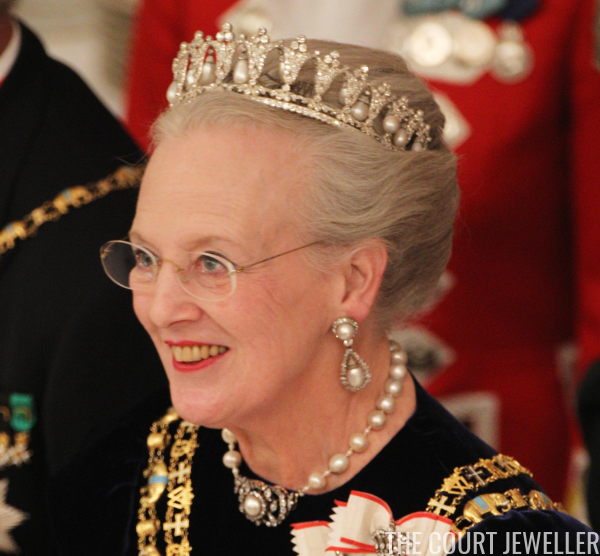 |
| Queen Margrethe II of Denmark wears the Pearl Poire Tiara as she celebrates her Ruby Jubilee at Christiansborg Palace, January 2012 [Chris Jackson/Getty Images] |
Denmark is perhaps one of the most tiara-rich countries in Europe, but even among their large cache of sparklers, a few tiaras stand out as particularly historically important. One of these, the Pearl Poiré Tiara, highlights the maternal heritage of the country’s current monarch.
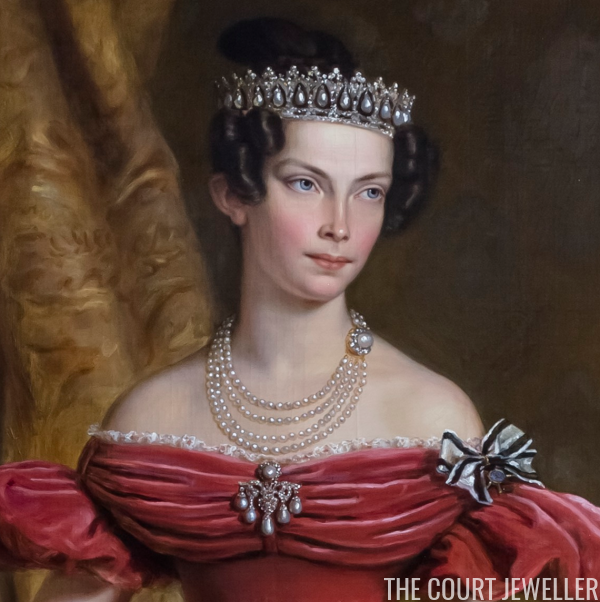 |
| Princess Louise of the Netherlands wears the tiara and its coordinating brooch in an 1836 portrait by Jean-Baptiste van der Hulst [Wikimedia Commons] |
The tiara, which is made of diamonds set with eighteen pear-shaped (or “poiré”) pendant pearls, is thought to have been made in the first half of the nineteenth century. In his book on Denmark’s royal jewels, Bjarne Steen Jensen notes that the tiara was a wedding gift in 1825 to Princess Louise of Prussia on her marriage to Prince Frederick of the Netherlands. Louise was the daughter of King Friedrich Wilhelm III of Prussia, which has led many to presume that the tiara was made in present-day Germany, most likely in Berlin. The tiara was accompanied by a diamond brooch with five pearl pendants.
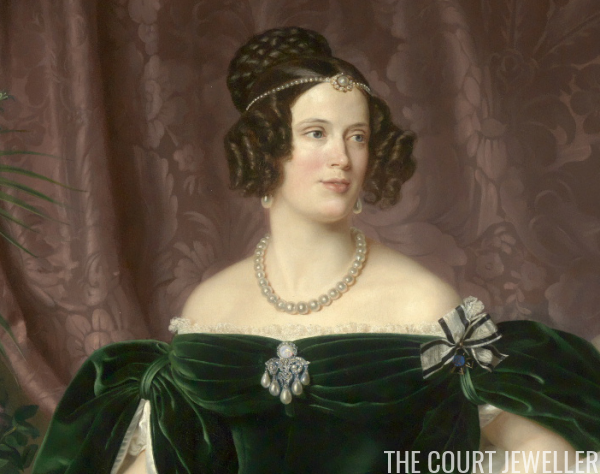 |
| Princess Marianne of Prussia is depicted wearing her matching pearl and diamond brooch in an 1837 portrait by Theodor Hildebrandt [Wikimedia Commons] |
Intriguingly, Princess Louise’s pearl tiara and brooch set also had a twin. Louise’s brother, Prince Albrecht, married Princess Marianne of the Netherlands in 1830, and King Friedrich Wilhelm gave his new daughter-in-law another diamond tiara set with pendant pearls. According to Jensen, Marianne’s pearl tiara was inherited by her daughter, Princess Alexandrine, who married Duke Wilhelm of Mecklenburg-Schwerin. Alexandrine’s daughter, Charlotte, is the last known owner of the twin tiara; its whereabouts today are apparently a mystery.
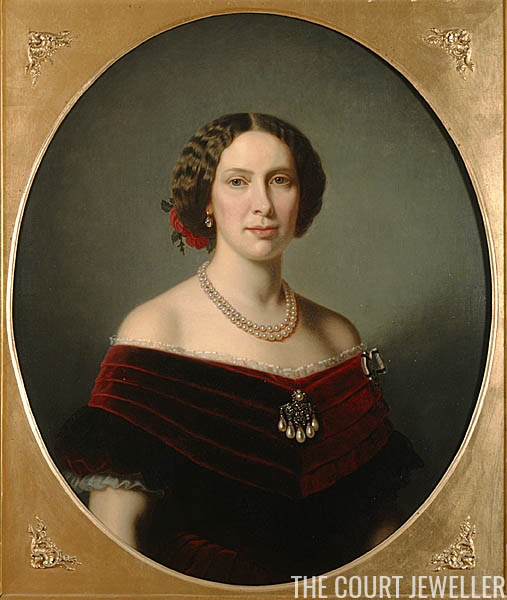 |
| Queen Louise of Sweden and Norway never wore the tiara, but she wears its coordinating brooch with the five pearl pendants in this portrait by Amalia Lindegren [Wikimedia Commons] |
But we know what happened to Louise’s tiara — it ended up in Denmark, and we can easily trace its path from The Hague to Copenhagen. In 1849, Prince Frederick and Princess Louise helped to arrange a marriage between their eldest daughter, Princess Louise, and Crown Prince Charles of Sweden. It wasn’t a happy marriage; Louise was very much in love with Charles, but he reportedly didn’t find her attractive and treated her with disdain and neglect. But in 1859, when his father died, the couple became King Charles XV and Queen Louise of Sweden and Norway. They managed to have two children, but only one, Princess Lovisa, lived to adulthood.
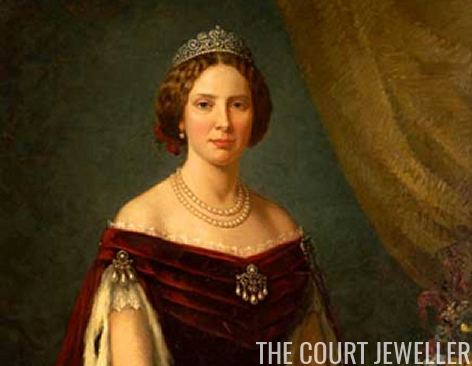 |
| Queen Louise of Sweden and Norway also wears the coordinating diamond and pearl brooch in this unattributed portrait, which appears to be a derivative of the Lindegren portrait above [Wikimedia Commons] |
Meanwhile, back in the Netherlands, Princess Louise became ill. In late 1870, Queen Louise traveled to be with her mother on her deathbed. Princess Louise died in December, and in her will, she left the Pearl Poiré Tiara to Queen Louise. But a bit of very bad timing intervened. Queen Louise made her way back to Stockholm, but not long after she returned, she caught pneumonia. Before the contents of her mother’s estate could be distributed, Queen Louise died, too. She never got to wear the pearl tiara.
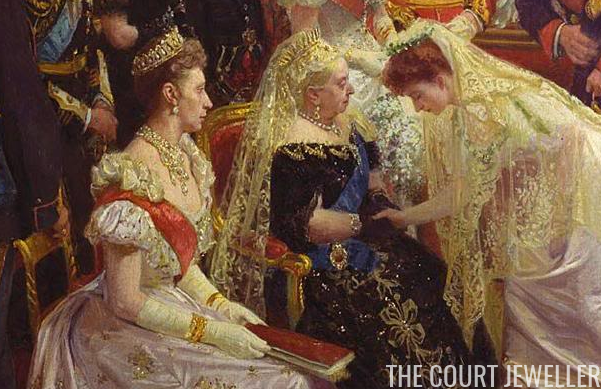 |
| Crown Princess Lovisa of Denmark wears the tiara at the marriage of Prince Carl and Princess Maud, as seen in this detail from Laurits Tuxen’s 1897 painting of the wedding [Wikimedia Commons] |
Appropriately, the tiara was subsequently given to Queen Louise’s only daughter, Princess Lovisa. Even though Lovisa was the only living child of King Charles XV, the constitution in Sweden at the time prevented her from inheriting her father’s throne. Instead, she had agreed in 1869 to a marriage with Crown Prince Frederik of Denmark. The tiara traveled with Crown Princess Lovisa to Copenhagen, and it has been in Danish hands ever since. In 1896, Lovisa wore the pearls at the marriage of her son, Prince Carl, to Princess Maud of Wales in London.
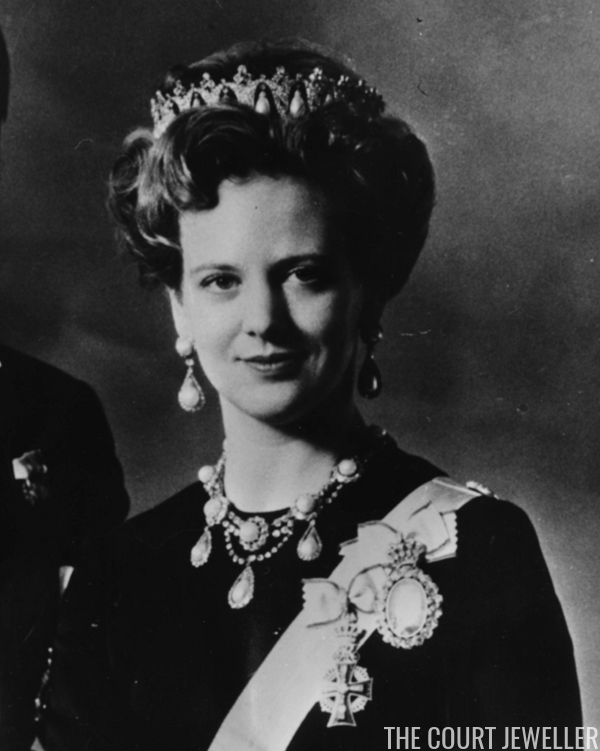 |
| Queen Margrethe II of Denmark wears the tiara, necklace, and earrings in a portrait taken in March 1972, just after her accession to the throne [Keystone/Hulton Archive/Getty Images] |
Frederik and Lovisa became Denmark’s king and queen in 1906. In Lovisa’s hands, the tiara became a part of a married parure, matched up with other similar pieces of pearl and diamond jewelry to make a set. A large diamond brooch with five pearl pendants had been made to match the tiara at the time of its original creation, and Lovisa inherited the brooch along with the tiara. She began wearing both pieces with a pearl and diamond necklace that she had received as a wedding gift from the Khedive of Egypt. Two pearl pendants that were originally part of that necklace were also later turned into earrings. One more piece was also added to this “parure” — a pearl and diamond cluster brooch, which was originally the clasp of an elaborate pearl necklace. This necklace had been Lovisa’s wedding gift from Tsar Alexander III of Russia and his wife, Maria Feodorovna (born Princess Dagmar of Denmark; she was a sister of Lovisa’s husband, Frederik).
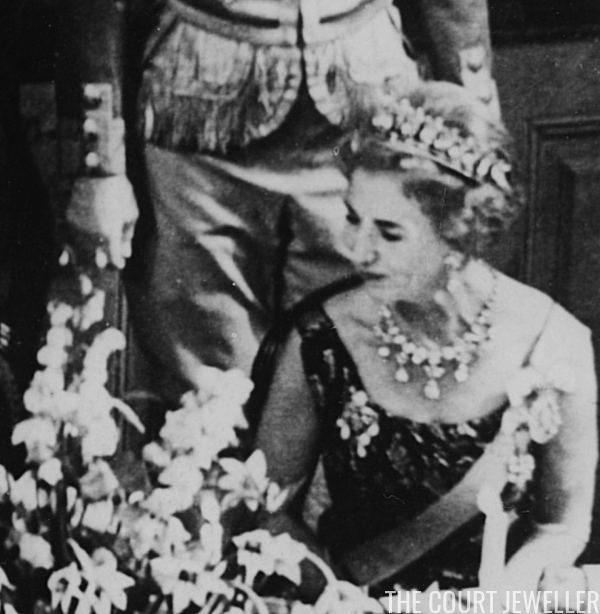 |
| Queen Ingrid of Denmark wears the tiara (with the necklace of diamond brilliants from the crown jewel collection) at Princess Anne-Marie’s farewell dinner at Fredensborg Castle in 1964 [Keystone/Hulton Archive/Getty Images] |
In her will, Lovisa placed this entire group of pearl and diamond jewels in trust, ensuring that the set could never be broken up. Although the suite is not a part of the Danish crown jewels, it passes directly from monarch to monarch, and it is generally worn only by the country’s queen. All of Lovisa’s successors — Queen Alexandrine, Queen Ingrid, and Queen Margrethe II — have worn the Pearl Poiré Tiara and the accompanying pearl and diamond jewels.
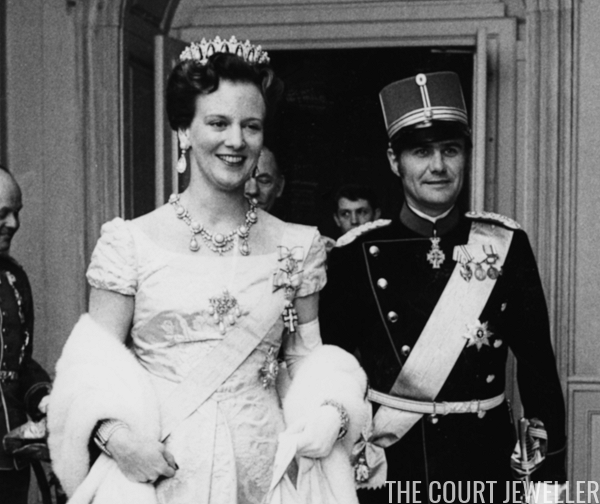 |
| Queen Margrethe II of Denmark wears the tiara, necklace, earrings, and brooch at a diplomatic corps reception, March 1973 [Keystone/Hulton Archive/Getty Images] |
On two separate occasions, though, the tiara has been worn by a member of the royal family acting as a representative of the monarch. In 1937, Crown Princess Ingrid borrowed the tiara from her mother-in-law for the coronation of King George VI and Queen Elizabeth of the United Kingdom. For the coronation of Queen Elizabeth II, Denmark was represented by Prince Axel and Princess Margaretha; she also borrowed and wore the pearl tiara.
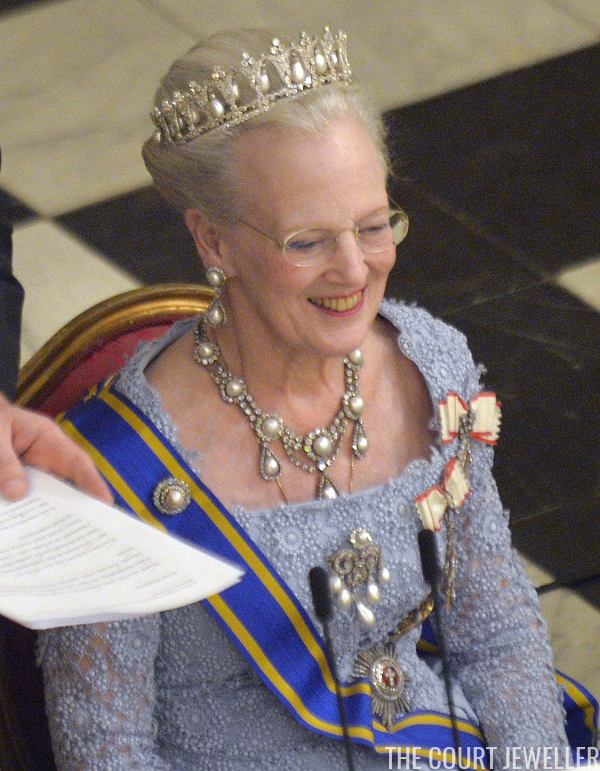 |
| Queen Margrethe II of Denmark wears the entire set (tiara, necklace, earrings, and both brooches) for the Dutch state banquet, March 2015 [SIMON LAESSOEE/AFP/Getty Images] |
Since her accession to the throne in 1972, the tiara has been worn by Queen Margarethe II. She has worn the tiara for numerous portraits, and she often wears it for prominent events, like state visits or the annual New Year’s Levees. In 2015, she selected the tiara for a very appropriate event: a banquet in honor of King Willem-Alexander and Queen Maxima of the Netherlands. The tiara was a bejeweled reminder of the monarchs’ shared family heritage, dating all the way back to its first owner, Princess Louise of the Netherlands.
Leave a Reply